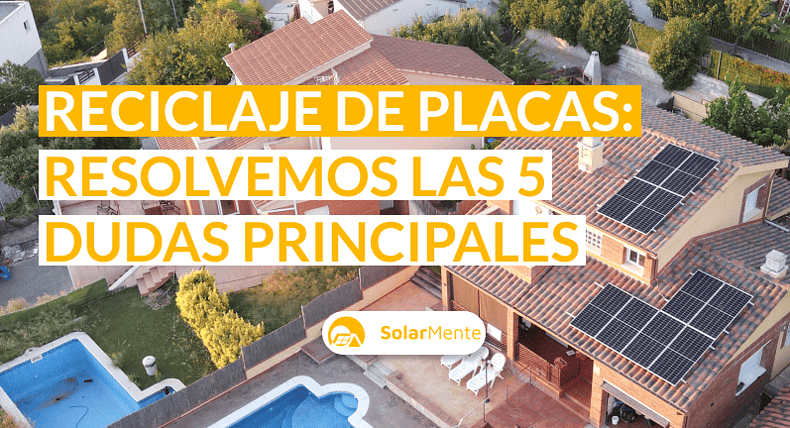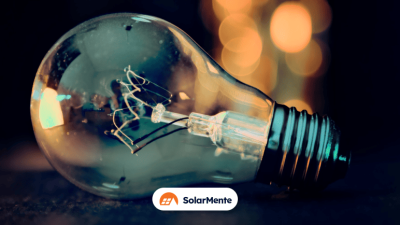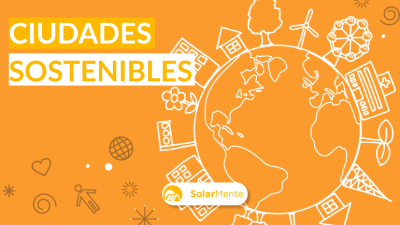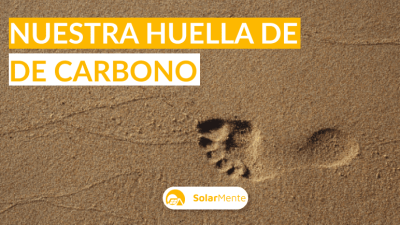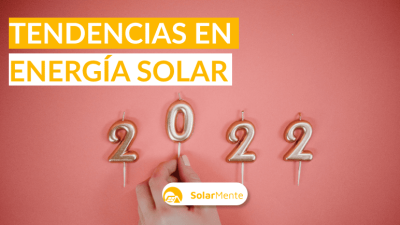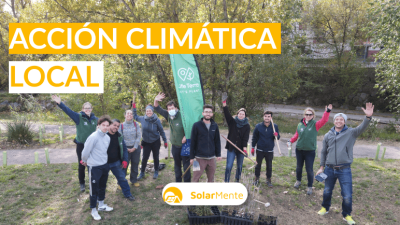Reducing dependence on fossil fuels, increasing the value of housing, reducing electricity consumption costs and reducing CO2 emissions are some of the advantages of solar energy.
But best of all, you can enjoy all these benefits over a period of time of up to 30 years thanks to the long life span of solar panels.
However, once the efficiency decreases due to the age of the system, what do we do with the used panels and can the components be recycled?
Not only can it be done, but the recycling of solar panels is an obligation.
In today’s article, we will take a look:
-
The regulations applicable to waste from the photovoltaic sector.
-
How solar panels are recycled, explained step by step.
-
Which companies are in charge of treating these wastes
-
The current situation in Spain
Regulations on the treatment of used solar panels
In the same way that we recycle electronics, paper and other items in our daily routine, solar panels can also be recycled once their performance starts to decline.
That is to say, after 20-30 years of useful life of the installation, the energy production starts to decrease and it is convenient to replace the solar panels with a new system.
The aim is not to reuse old, used or second-hand panels, as they will never achieve the same performance as if new modules were installed.
What should be done, as well as being mandatory by law, is the recycling of solar panels to make use of the materials in the generation of new products. This is important for both sustainability and the economy.
What are the regulations governing this process?
The European Union (EU) established in 2012 the responsibility of solar panel manufacturers to carry out this work. It is officially regulated under Directive 2012/19/EU on waste electrical and electronic equipment (WEEE).
Through Royal Decree 110/2015, Spain supports the initiative, obliging producers and importers to recycle solar panels once their useful life has ended, in the same way that the European law applies.
Thanks to this initiative, the members of the network are committed to creating a product that is sustainable in the production process, after purchase and at the dismantling stage.
In fact, the European Commission announced in 2012 the obligation for 80% of photovoltaic waste to be reusable and recyclable by 2018.
How to recycle solar panels?
The great advantage of solar panels is that we can recycle around 90% or even 95% of their materials, according to BloombergNEF.
Why such a high percentage? Because of the composition of the modules where glass and aluminium win the battle.
However, when the solar panels do not work properly and you want to replace them, what is the process to follow with the old modules? Should I recycle them like any other component?
As with electrical appliances, the recycling of photovoltaic panels is carried out in certain specialised centres.
The solar panels have to be taken to a clean point or approved centre for collection. Afterwards, the corresponding organisation will carry out the entire process, separating the components from each other with the aim of using them in the creation of other products.
However, if we are going to renew the photovoltaic system, the installation company is obliged to collect the old modules, provided that you have made the request. The old modules will then be taken to a clean point and the procedure will be repeated.
Step-by-step procedure for the recycling of solar panels
Once the modules arrive at the specialised centres, they are processed as follows:
-
The connection cables are cut to separate the copper and plastic.
-
The 100% reusable aluminium frame is separated from the solar panel.
-
The protective glass is removed for 95% reuse.
-
Finally, the remaining components can be removed by two processes:
-
Thermal process. The solar panels are subjected to a heat treatment of 500ºC to eliminate the plastic elements that may remain in the module. The silicon wafers are then separated with the intention of giving them a second life.
-
Mechanical or chemical process. The remaining components from the panel are crushed by chemical processes to extract and separate them. They are then processed into reusable materials.
-
Solar panel recycling companies in Spain
The modules of a photovoltaic installation can be reused almost in their entirety, but specific treatment is necessary, as mentioned above, and can only be done by certain specialised centres.
In Spain, there are two organisations that carry out this task: PV Cycle and Recyclia.
PV Cycle is a non-profit company that was founded in 2007, but did not start its economic activity until 2013 when it initiated a collaboration with Recyclia, the remaining company operating in Spain.
This second company started its activity in 2012, being the largest entity for waste electrical and electronic equipment (WEEE). It manages the waste through its foundation Ecoasimelec and hosts more than 400 companies involved in the recycling of photovoltaic modules.
What are the benefits of recycling your solar panels?
Recycling solar panels has a positive impact on the environment. The benefits we obtain are:
-
It reduces the use of landfill, which is harmful to the environment.
-
It reduces energy consumption. It does not require large amounts of energy as is the case with the processing of raw materials.
-
Minimises atmospheric pollution.
-
It restricts the exploitation of new natural resources.
The recycling of solar panels in Spain: the current situation
More than half of the municipal waste (54%) from Spain in 2019 ended up in landfills, according to the European Commission’s Environmental Policy Implementation Review report.
Compared to the waste generated by the rest of the European Union countries, we almost doubled the current figure of 24% on average.
At present, more than 30,000 tonnes of solar panel waste is generated each year worldwide, with a significant increase that could reach one million tonnes per year by 2035.
As we are below the European average in terms of quantities recycled, policies are needed to encourage the proper recycling of solar panels. Not only will this lead to a reduction of millions of tonnes of greenhouse gas effects, but it will also have an impact on a circular economy and create new jobs.
An increase that could reach 6 million jobs in activities related to recycling, repair or remanufacturing.
We are therefore talking about a fully-fledged economic opportunity.
Moreover, according to data from Rystad Energy, solar panels will be worth more than 2.7 billion dollars by 2030. An upward trend that could reach a value of close to 80 billion dollars by 2050.
In Spain, work is underway to create the first recycling centre for photovoltaic solar panels, where the waste is managed appropriately for subsequent reuse.
A market with a long way to go
Solar energy is not only a renewable and clean source of electricity generation, but once the useful life of the photovoltaic installation is over, we can recycle up to 95% of the elements. The good news is that these parts can be used to create other products, thus restricting the exploitation of new natural resources.
However, there is still a lot of work to be done. Action will be needed in the energy sector. Moreover, research will have a key role to play in ensuring proper recycling.
These practices will lead to the sustainability of our planet and significant growth in the global economy, creating new jobs and opportunities within the energy sector.
Frequently asked questions
How much does it cost to recycle solar panels?
Recycling is free of charge. The only work you have to do is to take the parts to a clean point so that specialised centres can collect the components and handle them.
Remember that if you are replacing your old system with a new one, the installation company is obliged to collect the used panels if you have given prior notice.
Are solar panels recycled?
Solar panels can be almost completely recycled as they are made of 85% glass, 4% plastic, 6% aluminium, 1% metal, 4% silicon. As of today, more than 95% of the panel can be recycled.
What happens to solar panels at the end of their life?
The International Renewable Energy Agency (IRENA) estimates a global production of 8 million tonnes of waste in 2030 after the first modules reach their useful life (25-30 years), and 78 million tonnes in 2050.
➡️Por For this reason, a massive deployment of self-consumption must take into account the basic guidelines of sustainable development, using the 3Rs theory: reduce, reuse and recycle.
How sustainable are panels?
During their lifetime of approximately 30 years, solar modules generate more electricity than was consumed during their production. Energy payback times vary between 3 and 6 years for various solar climates around the world. In general, silicon PV panels pay back the initial energy costs required for production well before their lifetime and are net energy generators for most of their lifetime.
What happens at the end of the solar panels’ lifetime?
As with other electronic waste, solar panels should not be disposed of in regular landfills. They must follow a complete recycling process and require standardised recycling facilities that are properly equipped. Initiatives that hold manufacturers directly responsible for end-of-life panels will ensure that 96% of solar panels are recycled.

